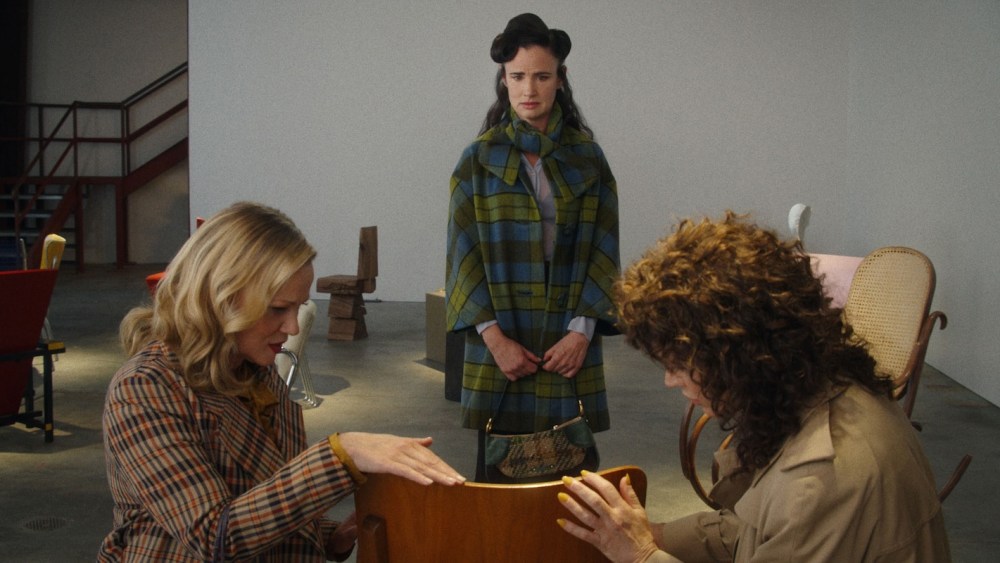Juliette Lewis Becomes a Chair
The logline for Amanda Kramer’s latest film, “By Design,” sounds both like the setup and the punchline for a winking joke. When a woman becomes envious and enamored with a striking wooden chair, she suddenly finds herself becoming said chair. Or rather, she ends up swapping bodies with it, forced to live thereafter as the inanimate object she was once so enthralled by. Outlandish and absurd in equal measure, Kramer’s Sundance dramedy is so obviously operating on its own quirky wavelength that when it eventually runs out of steam, you’re left wishing the “Please Baby Please” filmmaker could’ve pulled off this high-wire act.
When Camille (Juliette Lewis) arrives at a chair store with two chatty friends who barely register her presence, let alone her wants and desires, she’s hardly impressed with what she sees. The space is more of an art gallery than a furniture showroom. Each single chair boasts its own spotlight. None of what’s in stock inspires Camille. Not the simple rocking chair and not the short stool. Not the whimsically pink one nor the bright yellow one … until that is, she is taken by what the film’s narrator (Melanie Griffith) tells us is a “stunner” of a chair.
That’s the moment that will forever change her life. By the following morning, her body will lay limp at the store, and Camille will watch as her new body — simple, wooden, with armrests but no padding — is taken to its new home. There, she’ll fall in love with Olivier (Mamoudou Athie), the begrudgingly proud new owner of the designer chair on which Camille had once pinned her hopes.
“By Design” follows not just Camille’s journey as Olivier soon becomes obsessed with his new chair — sensing, perhaps, that a woman’s consciousness is trapped within it — but also the plight of Camille’s body. Left at her apartment, her body can do little else but remain still. (Even transposed to a new body, what else would a chair do?) But rather than raise alarm, her listless demeanor ends up dredging up difficult conversations with her mother (Betty Buckley), her friends (Samantha Mathis and Robin Tunney) and later still with a creepy, stalking neighbor (Clifton Collins Jr.). What Camille wasn’t able to do in her everyday life, her chair-like person accomplishes with surprising ease. Here she’s finally clued into the interior worlds of those closest to her. Alas, she’s not there to witness it.
Kramer has clearly no use for nor allegiance to any semblance of realism. Hers is a film whose stylistic flourishes nod more to avant-garde theater (to Ionesco, Durrenmatt, Sartre and the like) than to any grounded naturalism in film. Her stagey sets, vintage-styled wardrobe, and stark use of lights insist we relish the surreality of the proceedings. From the clipped, Pinter-like dialogue that opens the film (“I need a chair.” “For what?” “Guests.”) to the deadpan narration that runs throughout (“It’s so easy to compliment a gorgeous chair,” Griffith tells us), Kramer sets a droll tone for the film that makes it clear we are not to take any of it too seriously.
Though, as it soon becomes clear, there are serious issues being drawn out. To envy a chair (or to covet one to the extent Camille and Olivier come to do) is preposterous. That is, unless, as Kramer does, you dig into what that might tell us about these characters’ oft-crippling anxieties regarding who they are, what they want and how they wish to be perceived. It is only through plunging us through the very ludicrousness of, say, Camille’s mother bonding with her immobile, dead-eyed daughter that “By Design” punctures through what is expected of women like Camille. Might she really be a more amiable person when possessed by a chair? Does she end up learning more about her desires when being fully stripped of her own body? Kramer’s curiosity about such questions and her game cast’s ability to key into her twee existentialism make for a fascinating if eventually quite trying proposition.
The film’s two leads do right by what Kramer requires of them. Lewis’ kookiness is grounded into Camille’s molasses kind of melancholy. She may spend most of the film unable to move, but her expressive face and twitchy demeanor in the early scenes is enough to sketch out who Camille is. Meanwhile, Athie finds warmth in Olivier’s detachment, ably using his deep voice for a stilted delivery that makes this wayward man feel quite at home bonding with a single chair.
But it is Griffith’s voiceover narration which best captures “By Design”’s mix of wry comedy and rueful drama. In her first role in close to five years, she makes the film’s simple if peculiar dialogue (“Who needs or appreciates Camille as much as they do a chair?”) sound completely normal. Her casual tone throughout is what puts you at ease even when what you’re watching feels distractingly absurd (like modern dance interludes choreographed by Sigrid Lauren, set to the darkly whimsical score by Giulio Carmassi and Bryan Scary).
Kramer remains a master of her craft, capable of dreaming up realities that exist unto themselves and bringing along a cast who surrender themselves to her artistry. Lewis, Athie, Griffith and even Udo Kier (who appears briefly as the chair’s designer) are a treat throughout. And there is, no doubt, a welcome ambition to use fabulation to unpack contemporary questions about identity and desire. But Kramer’s wisp of a short story ultimately buckles under its own weight as it careens toward its final act and the witty final line that helps give the film its title. This is because “By Design,” for all its playful seriousness, works infinitely better as an intellectual exercise than as a finished film; perhaps better still as a winking joke than as a full-fledged affair.


